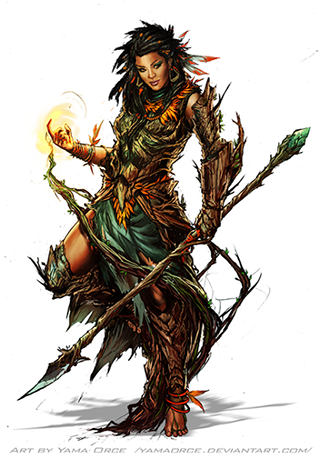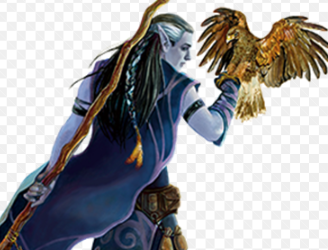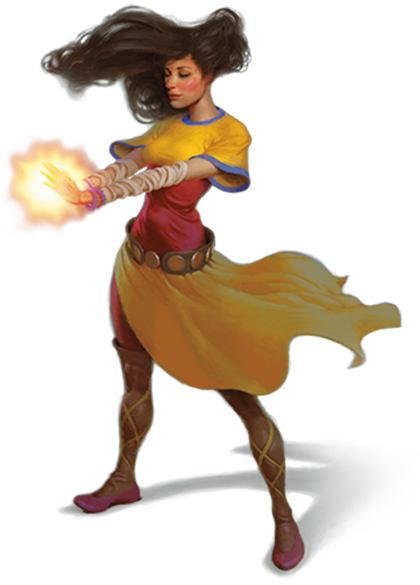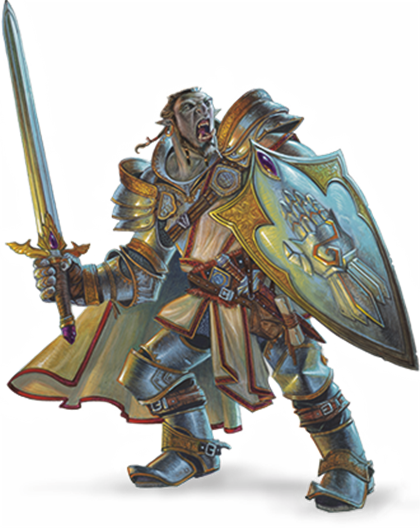Deep Dive into the Druid Class in D&D 5e – The Primal Spellcasters
Contents
In Dungeons & Dragons 5th Edition, the Druid is a spellcasting class that draws its power from the forces of nature. Druids are mystics of the natural world, attuned to the primal magic that flows through plants, animals, and the very essence of the wilderness. They are fierce protectors of nature and have the ability to shape-shift, commune with animals, and wield nature-based magic.

Druid 5e is an extremely adaptable class in Dungeons and Dragons games. Between their accessible paradigms, they’re ready to serve blends of jobs as scouts, strikers, blasters, bolster casters, and controllers. Their spell list has a ton of one-of-a-kind choices, there is a solid accentuation on region control spells, and a large portion of the Druid’s best spells require Focus. By spellcaster principles, this makes the Druid 5e moderately easy to play since you so once in a while need to follow more than one continuous spell impact, however, it unquestionably doesn’t make them less fun or less ground-breaking.
Druid 5e
Druids possess a unique set of abilities that distinguish them from other spellcasting classes. Here are some key aspects of the Druid class.
- Spellcasting: Druids have a deep connection to nature and can harness their power to cast spells. They gain access to a diverse array of spells that reflect their affinity for the natural world. Druid spells often focus on healing, elemental manipulation, summoning creatures, and environmental control.
- Wild Shape: One of the defining features of Druids is their ability to shape-shift into different animal forms through the Wild Shape ability. By assuming the shape of animals, Druids gain new abilities, enhanced physical attributes, and increased versatility. This ability allows Druids to adapt to different situations and fulfill various roles within a party.
- Druidic Circle: At the 2nd level, Druids choose a Druidic Circle, which represents their specialized focus within the class. The two core options are the Circle of the Land and the Circle of the Moon. The Circle of the Land emphasizes the Druid’s connection to specific environments, granting additional spells and terrain-related benefits. The Circle of the Moon focuses on the Druid’s shape-shifting abilities, allowing them to assume more powerful forms and become formidable combatants.
- Nature Bond: Druids have a deep bond with nature and can communicate with animals. This ability, known as the Beast Speech, enables Druids to understand and convey simple messages to beasts. Additionally, Druids can call upon animals to aid them in various ways, from providing information and assistance to engaging in combat alongside them.
- Ritual Casting: Druids possess the Ritual Casting feature, allowing them to perform certain spells as rituals. Ritual spells can be cast without expending spell slots, which makes Druids versatile in performing sacred rites, communing with nature, and utilizing utility spells.
- Nature’s Wrath: As they progress in levels, Druids gain access to potent nature-themed abilities. This includes spells that can control the environment, summon creatures, manipulate elements, and unleash the fury of nature against their foes.
Druids excel in outdoor environments, where their connection to nature is strongest. They have a unique blend of healing, offensive, and utility magic, combined with the ability to transform into powerful beasts. With their versatility, Druids can fulfill roles such as healers, buffers, controllers, and front-line combatants, making them valuable assets to any adventuring party. Their commitment to preserving the balance of nature adds depth and an ethical dimension to their character, making them fascinating to roleplay.
Read also; Fighter Class

At their center, Druid 5e is a nature wizard. They have indistinguishable sum and breakdown of spell openings from a Wizard does, with the main special case being that wizards learn one extra cantrip and have a lot bigger pool of spells to pick. What do druids get? The entirety of their enchantment is centered around nature and life.
Hit Points
- Hit Dice: 1d8 per druid level
- Hit Points at 1st Level: 8 + your Constitution modifier
- Hit Points at Higher Levels: 1d8 (or 5) + your Constitution modifier per druid level after 1st
Proficiencies
- Armor: Light armor, medium armor, shields (druids will not wear armor or use shields made of metal)
- Weapons: Clubs, daggers, darts, javelins, maces, quarterstaffs, scimitars, sickles, slings, spears
- Tools: Herbalism kit
- Saving Throws: Intelligence, Wisdom
- Skills: Choose two from Arcana, Animal Handling, Insight, Medicine, Nature, Perception, Religion, and Survival
Equipment
You start with the following equipment…
- (a) a wooden shield or (b) any simple weapon
- (a) a scimitar or (b) any simple melee weapon
- Leather armor, an explorer’s pack, and a druidic focus
In contrast to wizards, druids can get the hang of recuperating spells, can wear up to medium protection, convey a shield, and even have some cool weapon proficiencies (in spite of the reality they won’t wear reinforcement or use shields that are made of metal).
| Level | Proficiency Bonus | Features | Cantrips Known | Spell Slots, Spell Level |
||||||||
|---|---|---|---|---|---|---|---|---|---|---|---|---|
| 1st | 2nd | 3rd | 4th | 5th | 6th | 7th | 8th | 9th | ||||
| 1st | +2 | Druidic, Spellcasting | 2 | 2 | - | - | - | - | - | - | - | - |
| 2nd | +2 | Wild Shape, Druid, Circle | 2 | 3 | - | - | - | - | - | - | - | - |
| 3rd | +2 | - | 2 | 4 | 2 | - | - | - | - | - | - | - |
| 4th | +2 | Wild Shape improvement, Ability Score Improvement | 3 | 4 | 3 | - | - | - | - | - | - | - |
| 5th | +3 | - | 3 | 4 | 3 | 2 | - | - | - | - | - | - |
| 6th | +3 | Druid Circle feature | 3 | 4 | 3 | 3 | - | - | - | - | - | - |
| 7th | +3 | - | 3 | 4 | 3 | 3 | 1 | - | - | - | - | - |
| 8th | +3 | Wild Shape improvement, Ability Score Improvement | 3 | 4 | 3 | 3 | 2 | - | - | - | - | - |
| 9th | +4 | - | 3 | 4 | 3 | 3 | 3 | 1 | - | - | - | - |
| 10th | +4 | Druid Circle feature | 4 | 4 | 3 | 3 | 3 | 2 | - | - | - | - |
| 11th | +4 | - | 4 | 4 | 3 | 3 | 3 | 2 | 1 | - | - | - |
| 12th | +4 | Ability Score Improvement | 4 | 4 | 3 | 3 | 3 | 2 | 1 | - | - | - |
| 13th | +5 | - | 4 | 4 | 3 | 3 | 3 | 2 | 1 | 1 | - | - |
| 14th | +5 | Druid, Circle feature | 4 | 4 | 3 | 3 | 3 | 2 | 1 | 1 | - | - |
| 15th | +5 | - | 4 | 4 | 3 | 3 | 3 | 2 | 1 | 1 | 1 | - |
| 16th | +5 | Ability Score Improvement | 4 | 4 | 3 | 3 | 3 | 2 | 1 | 1 | 1 | - |
| 17th | +6 | - | 4 | 4 | 3 | 3 | 3 | 2 | 1 | 1 | 1 | 1 |
| 18th | +6 | Timeless Body, Spells | 4 | 4 | 3 | 3 | 3 | 3 | 1 | 1 | 1 | 1 |
| 19th | +6 | Ability Score Improvement | 4 | 4 | 3 | 3 | 3 | 3 | 2 | 1 | 1 | 1 |
| 20th | +6 | Archdruid | 4 | 4 | 3 | 3 | 3 | 3 | 2 | 2 | 1 | 1 |
Druids of the Hover of the Moon center around their shape-moving capacities. They can change into bigger animals and at a lot of prior levels. In the long run, their mammoth assaults will consider otherworldly and you can even transform into a basic. Remember that you don’t need to be a darker bear constantly and you can, in any case, give a ton of utilization to the gathering in your non-Mammoth structure by throwing spells and utilizing cantrips. It never damages to have a crisis bear on hold on. Nobody expects a crisis bear.
Attributes
| Hit Die | d8 |
| Spellcasting Ability | Wisdom |
| Starting Gold | 2d4 x 10 |
| Subclass Name | Druid Circle |
| Suggested Abilities | Wisdom, Constitution |
Arctic
| 3rd | Hold Person, Spike Growth |
|---|---|
| 5th | Sleet Storm, Slow |
| 7th | Freedom of Movement, Ice Storm |
| 9th | Commune with Nature, Cone of Cold |
Coast
| 3rd | Mirror Image, Misty Step |
|---|---|
| 5th | Water Breathing, Water Walk |
| 7th | Control Water, Freedom of Movement |
| 9th | Conjure Elemental, Scrying |
Desert
| Druid Spells | Circle Spells |
|---|---|
| 3rd | Blur, Silence |
| 5th | Create Food and Water, Protection from Energy |
| 7th | Blight, Hallucinatory Terrain |
| 9th | Insect Plague, Wall of Stone |
Forest
| Druid Spells | Circle Spells |
|---|---|
| 3rd | Barkskin, Spider Climb |
| 5th | Call Lightning, Plant Growth |
| 7th | Divination, Freedom of Movement |
| 9th | Commune with Nature, Tree Stride |
Grassland
| Druid Spells | Circle Spells |
|---|---|
| 3rd | Invisibility, Pass without Trace |
| 5th | Daylight, Haste |
| 7th | Divination, Freedom of Movement |
| 9th | Dream, Insect Plague |
Mountain
| Druid Spells | Circle Spells |
|---|---|
| 3rd | Spider Climb, Spike Growth |
| 5th | Lightning Bolt, Meld into Stone |
| 7th | Stone Shape, Stoneskin |
| 9th | Passwall, Wall of Stone |
Swamp
| Druid Spells | Circle Spells |
|---|---|
| 3rd | Acid Arrow, Darkness |
| 5th | Water Walk, Stinking Cloud |
| 7th | Freedom of Movement, Locate Creature |
| 9th | Insect Plague, Scrying |
Insights in D&D speak to how your 5e character interfaces with the world and what they can (and can’t) achieve. Work with your DM to guarantee you are creating your measurements equivalent to the remainder of your gathering and whatever technique picked, you will produce 6 distinct numbers; 1 for each property. At the point when you have your numbers, it’s essential to organize your insights to take advantage of them.
Beast Shapes
| Level | Max CR | Limitations | Example |
|---|---|---|---|
| 2nd | January 4, 2020 | No flying or swimming speed | Wolf |
| 4th | January 2, 2020 | No flying speed | Crocodile |
| 8th | 1 | — | Giant eagle |
In the first place, take the most elevated measurement and use it for your Intelligence score. As you can wear a medium defensive layer, you need to ensure you are maxing your air conditioning (how hard it is for animals to hit you in battle) at a +2, which means giving it a 14 or 15, on the off chance that you have it accessible. At last, the constitution ought to be one of your higher details. This gives you more hit focuses each time you level and makes it harder for your character to pass on.
The exact opposite thing I will refer to about Druid spells is that not normal for a Wizard’s spellbook, you’re not stuck knowing these spells always (aside from cantrips, you break it, you got it). During any long rest, a Druid can swap out their spells, so don’t hesitate to mess with every one of them and see what you like.
Preserve the Balance
The “Preserve the Balance” Druid is a homebrew subclass for the Druid class in Dungeons & Dragons 5th Edition. This subclass focuses on maintaining the delicate equilibrium of nature and harnessing its power to protect and restore the natural world. Here is an overview of the features and abilities that define the Preserve the Balance Druid subclass:
- Nature’s Equilibrium: At 2nd level, you gain the ability to manipulate the balance of natural forces around you. As an action, you can choose one of the following effects:
- Balance of Restoration: Restore hit points to yourself or an ally within range.
- Balance of Disruption: Inflict damage on an enemy within range.
- Balance of Preservation: Grant temporary hit points to yourself or an ally within range.
- Nature’s Sanctuary: Starting at 2nd level, you gain an enhanced connection to nature, granting you resistance to damage from environmental hazards such as extreme temperatures, natural toxins, or difficult terrain. Additionally, you have an advantage on saving throws against spells and effects that would alter your form or control your mind.
- Nature’s Wrath: At the 6th level, your spells and abilities that deal damage become attuned to the forces of nature. Whenever you deal damage to a creature, you can choose an additional damage type from a list of nature-themed options (e.g., lightning, acid, cold). This additional damage type bypasses resistances and immunities if the creature does not possess resistance or immunity to the chosen damage type.
- Balance of Harmony: Starting at the 10th level, you can use your Nature’s Equilibrium feature twice before needing a short or long rest to recharge. Additionally, when using the Balance of Restoration effect, you can remove one of the following conditions from the target: blinded, deafened, poisoned, or diseased.
- Balance of Renewal: At the 14th level, you gain the ability to tap into the regenerative powers of nature. Once per long rest, you can expend a use of your Wild Shape ability to restore hit points to yourself and all allies within a certain radius. The amount of hit points restored increases with your Druid level.
Please note that this “Preserve the Balance” Druid subclass is a homebrew creation and not an official subclass from the Dungeons & Dragons 5th Edition sourcebooks. It is important to discuss any homebrew content with your Dungeon Master to ensure it aligns with the campaign and maintains game balance.
Create a Druid class
To create a Druid character in Dungeons & Dragons 5th Edition, follow these steps:
Step 1: Choose a Race
Select a race for your Druid character. Some races that align well with the Druid class include Wood Elf, Hill Dwarf, Firbolg, and Variant Human. Consider racial traits that boost your Wisdom (the primary spellcasting ability for Druids) and provide nature-themed abilities.
Step 2: Determine Ability Scores
Assign your ability scores. Wisdom should be your highest ability score since it affects your spellcasting ability as a Druid. Constitution is also important for your hit points and concentration checks. Dexterity and Wisdom are useful for AC and initiative rolls. Strength and Charisma are generally less crucial for a Druid, but it’s up to your preference and character concept.
Step 3: Choose a Druidic Circle
Select a Druidic Circle to define your character’s specialization. The two core options are the Circle of the Land and the Circle of the Moon. The Circle of the Land focuses on spellcasting and offers benefits tied to specific environments. The Circle of the Moon enhances your shape-shifting abilities, allowing you to assume more powerful animal forms.
Step 4: Select Skills and Proficiencies
As a Druid, you gain proficiency in light and medium armor, shields (excluding metal), and Druidic-focused weapons like clubs, daggers, darts, javelins, maces, quarterstaffs, scimitars, sickles, slings, and spears. You also gain proficiency in certain skills. Perception is typically a good choice, as well as others that align with your character’s background and role in the party.
Step 5: Choose a Background
Select a background for your Druid. Consider backgrounds that grant skills such as Nature, Survival, or Animal Handling. Background features like Outlander’s Wanderer or Hermit’s Discovery can complement the nature-focused theme of a Druid.
Step 6: Determine Spells and Cantrips
Druids have access to a wide range of nature-themed spells. Choose spells that suit your character concept and playstyle. Consider spells for healing, control, summoning animals, elemental manipulation, and environmental influence. Cantrips like Druidcraft and Guidance are often helpful choices.
Step 7: Flesh Out Your Character
Now that you have the mechanical aspects in place, develop your character’s backstory, personality, and motivations. Consider their connection to nature, their stance on preserving the balance, and their relationship with animals and the wilderness.
Druids start with simple weapons, a shield (if desired), and a choice between a scimitar or a simple melee weapon. You also start with an explorer’s pack and either a druidic focus (such as a staff or an orb) or a component pouch for spellcasting.
Remember to collaborate with your Dungeon Master to ensure your character fits within the campaign setting and any specific rules or restrictions in place. Have fun bringing your Druid character to life and embarking on adventures in the world of Dungeons & Dragons!
Frequently Asked Questions (FAQs)
Q: What is the primary ability score for a Druid?
A: Wisdom is the primary ability score for a Druid. It affects their spellcasting ability, the saving throw DCs for their spells, and their ability to perceive and interact with the natural world.
Q: Can Druids wear armor?
A: Druids have proficiency in light and medium armor, but they cannot wear metal armor or use shields made of metal. This limitation is due to their connection to nature and their aversion to disrupting the balance.
Q: Can Druids use weapons?
A: Yes, Druids have proficiency with a variety of weapons, including clubs, daggers, darts, javelins, maces, quarterstaffs, scimitars, sickles, slings, and spears. They can choose the weapons that suit their character concept and playstyle.
Q: What is Wild Shape?
A: Wild Shape is a unique ability of Druids that allows them to transform into animals they have seen before. It grants them the physical abilities and traits of the chosen animal form, such as flying, swimming, or improved strength. The forms they can take become more powerful as they level up.
Q: Can Druids cast spells while in animal form?
A: By default, Druids cannot cast spells while in animal form. However, at higher levels, they can gain access to the “Beast Spells” ability, which allows them to use their Wild Shape ability to cast spells while in animal form.
Q: What are Druidic Circles?
A: Druidic Circles represent a Druid’s chosen specialization or focus within the class. The two core options are the Circle of the Land and the Circle of the Moon. The Circle of the Land emphasizes spellcasting and grants additional spells and terrain-related benefits. The Circle of the Moon enhances shape-shifting abilities, allowing Druids to assume more powerful animal forms.
Q: Do Druids have healing abilities?
A: Yes, Druids have access to healing spells, which they can use to restore hit points to themselves and their allies. They can also use their Wild Shape ability to heal themselves during combat, assuming they have a Druidic Circle or class feature that grants this ability.
Q: Can Druids speak with animals?
A: Yes, Druids have a deep connection with nature and can communicate with animals through the Beast Speech ability. They can understand and convey simple messages to beasts, allowing them to gather information, seek assistance, or form alliances with the animal kingdom.
Q: Can Druids manipulate the environment?
A: Yes, Druids have access to spells that allow them to manipulate the environment and shape natural elements. They can create barriers, control weather, grow plants, create difficult terrain, and influence the natural world in various ways, showcasing their power over nature.
Q: Are there any restrictions on the types of spells Druids can cast?
A: Druids have access to a diverse spell list that primarily focuses on nature-themed spells. They can cast spells for healing, control, summoning animals, elemental manipulation, and more. However, Druids cannot cast spells that have the “metal” descriptor, as it goes against their aversion to disrupting the balance of nature.
Q: How do druids use solid spells?
A: The druid classification casts spells using its knowledge modifier, which means that druids’ spellcasting potential is decided by means of how suitable their knowledge stat is.
Q: What are practice and ritual casting?
A: As spellcasters, druids are capable of putting together which spells they diagram to use after each lengthy rest. Selecting from the listing of druid spells, your persona will be in a position to pick out as many spells to put together as equal to their knowledge modifier plus their modern-day level.
Q: Do druids get familiars or animal companions?
A: Druids are capable of seriously changing into animals and different beasts due to their connection to nature and its inhabitants. However, this regrettably no longer imply that they can shape special bonds with different animals as a human.
Q: When did Druids make their first look in D&D, and how do they range between editions?
A: Druid was first regarded in Eldritch Wizardry as a PC. That e-book used to be a complement to the Original D&D game.
Q: Why, from a lore perspective, are druids the only type who can solid the Flame Blade spell?
A: It comes from the druid’s connection to nature and used to be at the beginning of a druid spell. The druid’s connection with the hearth is additionally well-attested in A D&D sources.
Q: 5e multiclassing with a wizarding stage 1 and a druid degree 1?
A: You decide what spells you recognize and can put together for every type individually as if you have been a single-classed member of that class.


